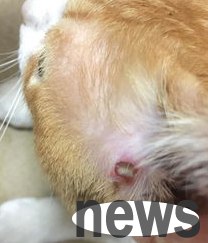Do dogs only have one ball? Or cryptorchidism!
The male dog has two small bells on its butt. In fact, these two small bells were not found at birth. Generally speaking, a dog's balls will fall into the scrotum only after about 1 month. But some dogs may have only one or even no balls as they get older. Why is this? It is possible that the dog's balls are lost, which leads to cryptorchidism.

What is cryptorchidism in canine?
Normally, every male mammal will have two testicles. When the embryo is in the development stage, the testicles are located approximately inside the abdominal cavity and behind the kidneys (similar to the ovary). As they develop and mature in the future, the testicles will fall into the scrotum along the traction of the sperm cord. Dogs are animals in the animal world whose testicles fall slowly to the scrotum, and their testicles fall into the scrotum within about one month of birth. If the puppy's testicles do not fall off after more than 6 months, the owner should pay attention to whether the dog has cryptorchidism. If the testicles are not in the scrotum when sexual maturity is 9 months old, it is cryptorchidism.
About 6%-12% of male dogs suffer from cryptorchidism, and the incidence rate of small dogs is relatively high. It is usually more common in dog breeds such as Maltese, Mini Popian, Pomeranian, Pekingese, Dachshund, Corgi, Puggo, French Bulldog, British Bulldog and other dog breeds. Cryptchilaria is divided into unilateral cryptorchidism and biperitoneal cryptorchidism, and is further divided into cryptorchidism in the groin and intraperitoneal cryptorchidism according to its location. Cryptidchidis in the groin belongs to subcutaneous cryptorchidis, which can be found through palpation. If the subcutaneous cryptorchidis cannot be found in the palpation, it means that the testicles have a high probability of being in the abdominal cavity.
The hidden dangers of cryptorchidism in canine
Testicular tumors are one of the common tumors in male dogs, and the incidence rate of dogs with cryptorchidism is several times that of normal dogs. The intraperitoneal cryptorchidism is more dangerous than the cryptorchidism in the groin. The reason is that the scrotum can maintain the most suitable ambient temperature for the testicles, but because the testicles do not fall into the scrotum, the testicles are easily transformed into malignant tumors in an environment with excessive temperature for a long time.
Therefore, when cryptorchidism is diagnosed, it is recommended to perform surgery early to remove the testicles to avoid other complications caused by cryptorchidism. The most common complication of cryptorchidism is echinoceros poisoning. After the testicles are tumorized, excessive emotional hormones may be secreted, leading to feminization of male dogs, such as bilateral symmetric hair loss, skin pigmentation, male and female lactation, etc. If there is too much eczema, it will also cause myelosuppression and cause pantothecinosis and coagulation dysfunction.

Treatment of Canine Cryptchilaria
Because the intraperitoneal cavity is located deep in the abdominal cavity, and the testicles of cryptorchilaria are usually small, it is difficult to determine the location of the testicles in the abdominal cavity. If you use traditional laparotomy surgery, you may need to open a large wound, and you will repeatedly turn the intestines and internal organs to find cryptorchidism. Fortunately, the technology of vegetative medicine is increasing, endoscopic minimally invasive surgery has occurred.
There are only two wounds of 0.3-0.5 cm in size during the operation, which greatly reduces pain, quick recovery after surgery, and reduces the chance of infection, and does not require hospitalization. If the wound in the surgical procedure uses absorbable sutures and surgical tissue glue bonding, and even without removing the stitches, the wound can recover the next day, and the postoperative care can become much easier.
Since cryptorchidism is easily inherited, it is recommended to sterilize dogs. The benefits of helping male dogs with ligation not only prevent testicular tumors, but also reduce aggressive behavior, reduce perianal adenomas, prostate problems, and the possibility of perineal hernia when old.
When a dog is young, the shoveler should always "start at the crotch" and pay close attention to the dog's testicles falling! Don't laugh, this is not lust, but a concern for the dog's health~




